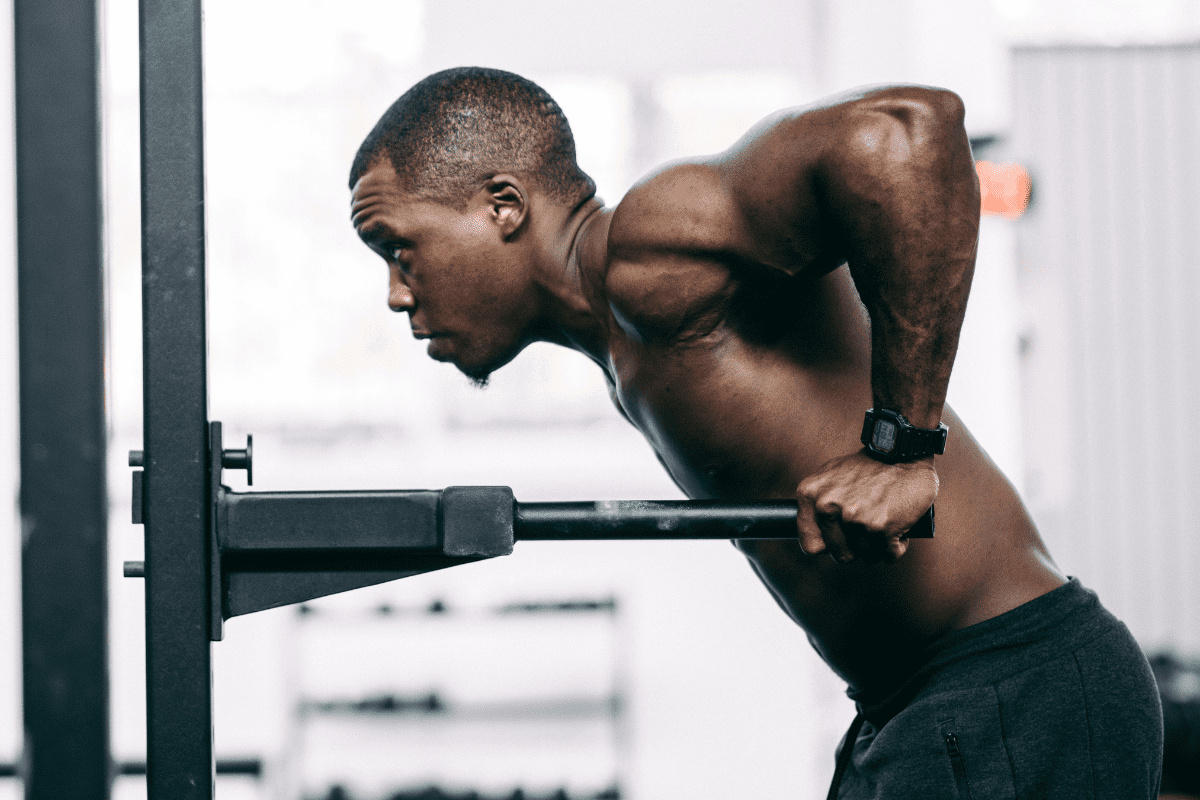11 Dips Alternatives to Build a Strong Chest and Triceps
Dips are one of the most effective exercises for building upper body strength. I would place them right up there with Bench Press and Pull-ups in their effectiveness in building both strength and mass.
However, sometimes you may find yourself needing an alternative for Dips.
Maybe you don’t have a dip attachment or maybe you’re just looking to add some variety to your workouts.
Whatever the reason, if you’re looking for an exercise to substitute for Dips then you’re in the right place. I’m about to share with you 10 of my favorite Dips alternatives including a few different variations and lifts using different equipment.
Alternatives to Dips
The first few alternatives I have listed are dip variations, using different pieces of equipment and varying levels of difficulty. If you really want to do Dips, but don’t have a dip bar, start here first.
The next few alternatives are compound movements, like dips, that target the triceps as well as the chest and shoulders. These are all good exercises to incorporate into your workout plan to build a strong upper body.
The last few alternatives are some of my favorite triceps isolation exercises. They’re all great if you’re looking to add some variety to your arm routine at the end of your workout.
Bench Dips
Bench Dips are an easier, more beginner-friendly variation of Dips. If you’re not quite ready for Dips yet (or you just don’t have a dip attachment), you may want to give Bench Dips a try.
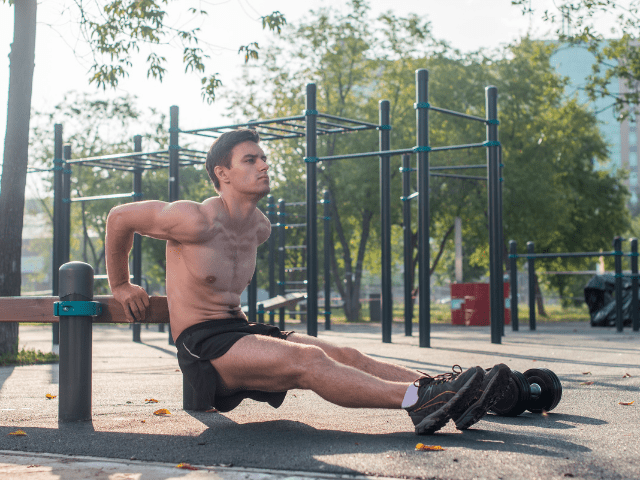
Step-by-Step Instructions
- Sit on the side edge of a bench and place the heels of your hands on the bench, fingers wrapping down over the edge.
- Place feet out in front of you, legs straight, heels on the ground.
- Push your body up by extending your arms and position yourself so your butt and torso are just off the edge of the bench.
- Bend the elbows and lower yourself down beside the bench.
- Stay close to the bench and keep your torso upright.
- Once the triceps become parallel to the ground, drive yourself back up to the starting position.
Coaching Points
The biggest mistake I see made with Bench Dips is getting the body too far away from the bench. This puts excess strain on the shoulders and can make the movement very uncomfortable. Keep your back close to the bench throughout the movement.
You can make bench dips easier by bending the knees and placing your feet flat on the floor or increase the challenge by elevating the feet on a box or adding weight plates to the thighs.
Ring Dips
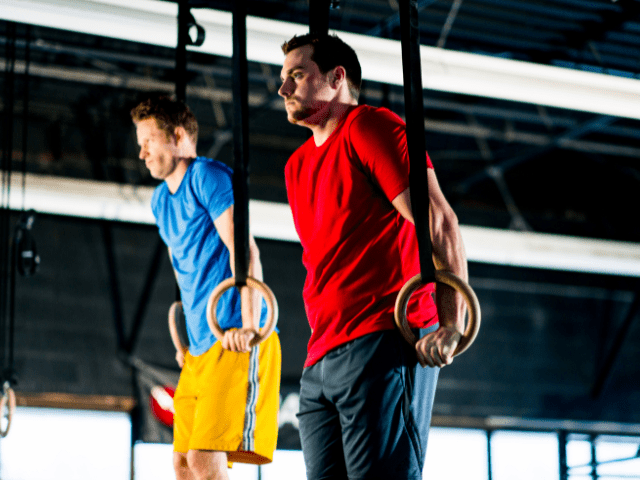
Ring Dips are a more advanced version of Dips and one of the most difficult upper body exercises one can do. Incorporating rings adds a ton of stabilization to the movement which can help athletes with keeping their shoulders healthy.
If you’re working out at home, Rings can be much more cost-effective than a dip attachment.
Step By Step Instructions
- Set your rings up on your rack. This process will vary based on your rings. Follow the manufacturer’s instructions closely.
- Set your rings just above waist height. This will allow enough room for your feet not to hit the ground while doing reps, but not so high you feel you have to jump up into your first rep.
- Starting position is hands on rings, arms extended, knees slightly bent and feet crossed (crossing feet is optional but does help with unwanted swinging in my experience).
- Descend down by bending the elbows and slightly leaning forward.
- Lower yourself under control until the triceps become parallel with the ground and then drive yourself back up to the starting position.
Coaching Points
*Need some creative options for hanging your gym rings? Here are 5 ways to hang gym rings at home.
The biggest mistake I see with dips is poor range of motion. If someone is struggling to be able to do reps, the easiest solution is to simply not lower yourself into a full rep, but this is incorrect. If a lifter cannot perform a full rep they should switch to one of the variations listed below.
The other issue I see my athletes run into is unwanted swinging front to back while doing reps. Stay under control, keep a consistent rep path, bend the knees and cross the feet. These are all solutions that I have seen help eliminate swinging while doing Dips.
Weighted Dips
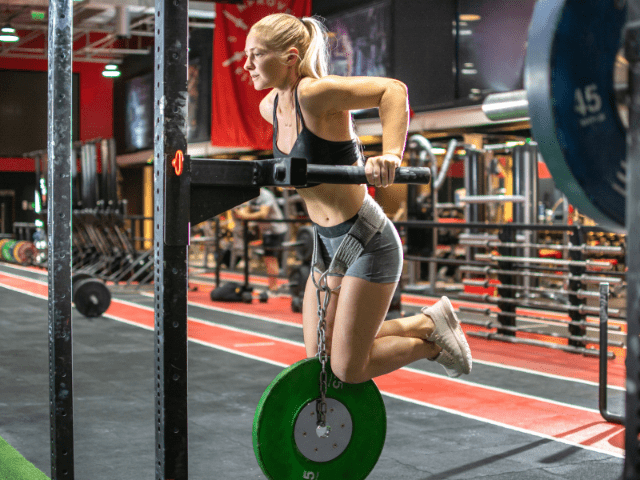
Once you’ve become efficient at regular Dips and sets of 15 to 20 are no longer challenging, it’s time to add some weight to your dips. There are multiple ways to add resistance for Weighted Dips and I’ve given a few examples below under Coaching Points.
Step By Step Instructions
- Attach your dip rack to your rack. This process will vary based on your rack and dip attachment. Follow the manufacturer’s instructions closely.
- Set your dip rack just above waist height. This will allow enough room for your feet not to hit the ground while doing reps, but not so high you feel you have to jump up into your first rep.
- Choose and setup the form of resistance you are using to add weight*.
- Starting position is hands on bars, arms extended, knees slightly bent and feet crossed (crossing feet is optional but does help with unwanted swinging in my experience.
- Descend down by bending the elbows and slightly leaning forward.
- Lower yourself under control until the triceps become parallel with the ground and then drive yourself back up to the starting position.
Coaching Points
*There are multiple ways to add weight to Dips. A couple of the most popular ways are:
- Wear a weighted vest.
- Wrap a lifting chain (used for bench and/or squat) over the shoulders.
- Hold a dumbbell with the feet.
- Using a dip belt with a chain designed to hang weight plates (pictured above).
Bench Press
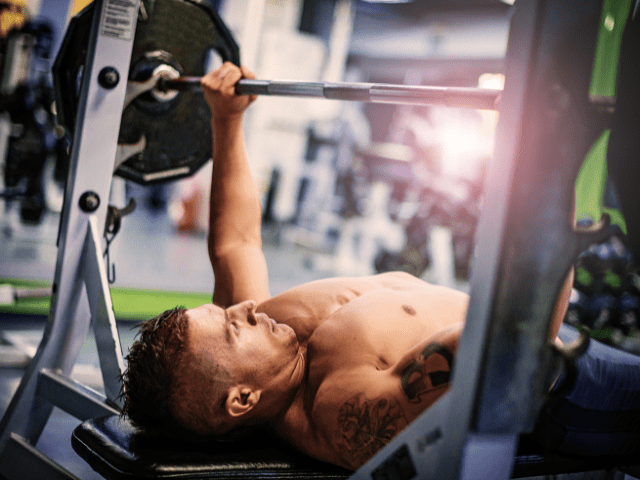
Bench Press and Dips really go hand-in-hand. In my opinion, they are the two most effective pressing movements for building a strong upper body.
Step-by-Step Instructions
- Set the height of the barbell so that when you unrack the barbell, you are only doing a very short upward concentric movement.
- Lie flat on your back on the bench.
- Keep your feet flat on the floor. (Some do find it comfortable to pull the feet back toward their butt as they arch).
- Keep your butt on the bench.
- Pull your shoulder blades together and keep the back of your head on the bench. You will slightly arch your back. Keep your core tight and keep the shoulder blades pulled back tight.
- Take a thumbs-width grip from the knurling and completely close your grip. Keep your knuckles pointing toward the ceiling and squeeze the barbell.
- Unrack the weight and take a deep breath.
- Control the barbell down during the eccentric movement and draw the barbell in, keeping the elbows at about a 45-degree angle away from the torso.
- The barbell will make contact with your torso right at the nipple line on the chest.
- Once contact is made, drive the barbell back up to the starting position.
Coaching Points
By far the most common mistake with bench pressing (and almost all compound movements) is improper form.
Because the lift is very technical, uses the whole body, and requires patience and persistence, lifters often times have incorrect form without realizing it, go up in weight too quickly, and may injure themselves.
Safety Tip: Make sure to always use a spotter when bench pressing with a barbell regardless of the weight being used.
BONUS ALTERNATIVE: Decline Bench Press
If you have access to a Decline Bench Press, whether it’s a standalone machine or an adjustable bench that drops down to a decline bench, Decline Bench Press can be a great alternative to Dips.
Because you’re pressing at a downward angle (compared to a flat bench), Decline Bench emphasizes the lower pectoral muscles much in the same way that Dips do.
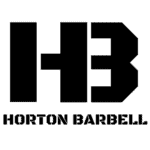
Tired of coming up with your own workouts? But don’t want to pay an arm and a leg?
I post workouts 5 days a week right here. (Did I mention they’re free?)
Close Grip Bench Press
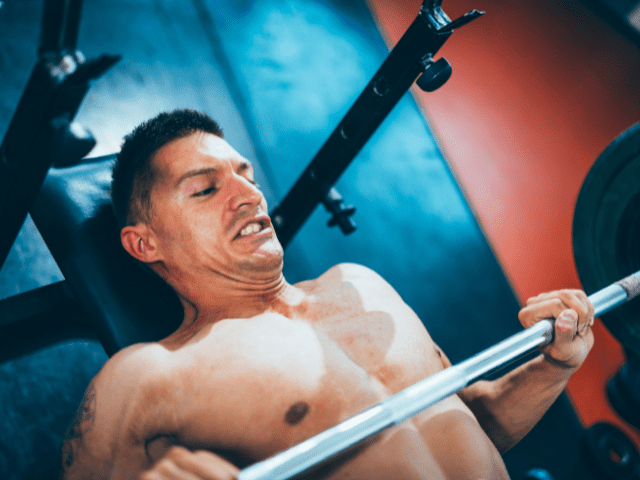
Close Grip Bench Press is a variation of Bench Press that places more emphasis on the triceps due to the narrower grip. This movement is probably the closest you can get to truly simulating the same muscle involvement as Dips.
Step-by-Step Instructions
- Set the height of the barbell so that when you unrack the barbell, you are only doing a very short upward concentric movement.
- Lie flat on your back on the bench.
- Keep your feet flat on the floor. (Some do find it comfortable to pull the feet back toward their butt as they arch).
- Keep your butt on the bench.
- Pull your shoulder blades together and keep the back of your head on the bench. You will slightly arch your back. Keep your core tight and keep the shoulder blades pulled back tight.
- Take a narrow grip, right at the start of the knurling and completely close your grip. Keep your knuckles pointing toward the ceiling and squeeze the barbell.
- Unrack the weight and take a deep breath.
- Control the barbell down during the eccentric movement and draw the barbell in, keeping the elbows tight to the body.
- The barbell will make contact with your torso right at the nipple line on the chest.
- Once contact is made, drive the barbell back up to the starting position.
Coaching Points
The two most important aspects of Close Grip Bench to pay attention to is the grip and the elbows. Often, beginners will make their grip too narrow. This can end up being very uncomfortable on the wrists and make the elbows more prone to flaring out.
Find a grip that is just inside shoulder-width and focus on keeping the elbows as tight to the body as possible.
Dumbbell Bench Press
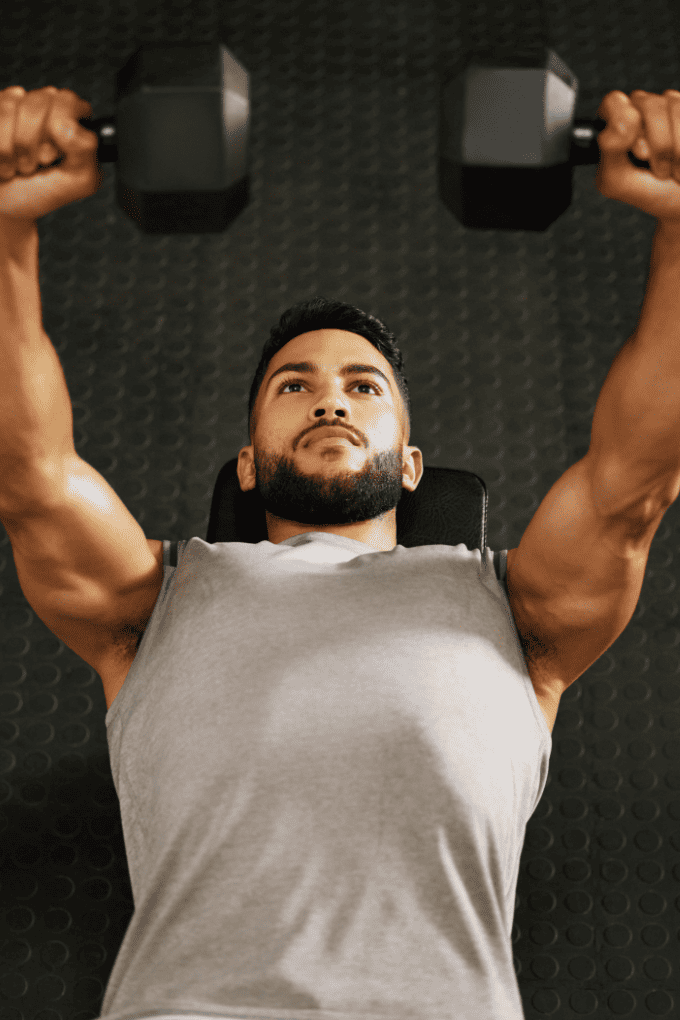
Dumbbell Bench Press is another bench variation that is effective and can be a little more friendly to the shoulder joint. Working with dumbbells allows the lifter more versatility in finding an optimal movement path that works best for them.
Step-by-Step Instruction
- Grab your dumbbells, sit on the edge of the bench, and sit the dumbbells on your thighs vertically.
- Take a deep breath, lie flat on your back on the bench, and get your dumbbells in position ready to press.
- Keep your feet flat on the floor.
- Keep your butt on the bench.
- Pull your shoulder blades together and keep the back of your head on the bench. You will slightly arch your back. Keep your core tight and keep the shoulder blades pulled back tight.
- The dumbbells should be slightly angled (representative of the path you are descending with your elbows).
- Press the dumbbells up.
- Control the dumbbells down during the eccentric movement and draw the dumbbells in, keeping the elbows at about a 45-degree angle away from the torso.
- The dumbbells will make contact with your torso right at the nipple line on the chest.
- Once contact is made, drive the dumbbells back up.
Coaching Points
Dumbbell Bench Press is a very shoulder-friendly pressing movement. Because the implement is a dumbbell, the range of motion is increased, the shear force on the shoulder is decreased, and the shoulder stabilizing muscles are engaged.
I would highly recommend this movement to any athlete. It provides all the benefits that a pressing movement can offer with minimal risk.
Remember to finish your sets with awareness so that you and your training partner/fellow gym members stay safe and injury-free.
Floor Press
If you don’t have a dip attachment and you don’t have a bench, Floor Press is the best Dip alternative available to you. It’s essentially Close Grip Bench Press done on the floor. The limited range of motion also puts even more focus on the triceps.
Step-by-Step Instructions
- Set your barbell up in the rack at the proper height to be able to rack and unrack the bar safely*.
- Lay on your back with knees bent, feet flat on the floor.
- Engage your lats and set yourself up basically the same as you would for Bench Press.
- Grab the bar using a close grip**, hands right about on the edge of the knurling.
- Unrack the bar, lower it down until the triceps lightly tap the floor and then press it back to extension.
Coaching Points
*Always test your barbell height with an empty bar. I’ve been doing Floor Presses for twenty years now and can still struggle with nailing the best height on my first try.
**Floor Press is generally done using a close grip to emphasize the demand on the triceps. However, you can go with a wider grip if you choose to.
Med Ball Pushups

Med Ball Pushups are another great chest and triceps-focused alternative to Dips. They’re extremely versatile because they are a bodyweight exercise where all the equipment that is needed is a medicine ball.
Step-by-Step Instructions
- Grab a medicine ball and find an open spot on the ground.
- Start on your knees and secure your hand placement on the ball first.
- Use a neutral grip hand position with palms facing one another on each outer edge of the ball.
- Now, lift the knees off the ground and raise up into a pushup starting position.
- Lower yourself down, keeping the elbows tight to the body as you descend.
- Lower down until the top of your abdomen (just below the sternum) touches the ball.
- Drive back up to the starting position.
Coaching Points
Perhaps the most important part of the entire lift is getting the proper hand placement on the ball. Don’t be afraid to experiment slightly with what hand position feels best as it may change slightly depending on the type and size of the medicine ball you are using.
Keeping the elbows tight to the body is key here to make sure that the focus stays on the triceps.
Bonus Exercise: Close Grip Pushups are very similar to Med Ball Pushups and don’t require any equipment at all. You’ll lose some of the stabilization benefits of Med Ball Pushups, but if you’re restricted on access to equipment they can be an extremely effective alternative.
Triceps Pushdowns

Triceps Pushdowns are the first of three of my favorite triceps isolation exercises. You’re not going to get the same chest and shoulders involvement, but if you’re looking for alternative triceps movements, Triceps Pushdowns are a tried and true hall-of-fame exercise.
Step-by-Step Instructions
- Step up a cable machine by sliding the pin all the way to the top of the beam.
- Attach the rack attachment of your choice.
- Grab the attachment and pull the attachment down until your elbows are next to your sides (arms should still be bent).
- Now, extend the arms down by flexing the triceps and driving the attachment toward the floor.
- Squeeze the triceps at full extension for one second and then slowly allow the attachment to raise back to the starting position.
- Keep elbows tucked into the sides throughout the movement.
Coaching Points
Do not swing and use momentum at the top of the movement in an attempt to use more weight. Stay in control of the weight at all times and use proper form.
If using a heavy weight, you can lean slightly forward at the waist to give yourself more stability and to help keep yourself anchored to the floor.
Band Triceps Pushdowns
If you’re working out in your garage like me, chances are you don’t have a thousand-plus dollar cable machine. However, a resistance band is something that most of us do have and if you do, Band Triceps Pushdowns are an excellent option for working your triceps.
Step-by-Step Instructions
First, loop a band around the top of a rack or any other piece of equipment that can solidly hold the band.
- Stand tall, head up.
- Hold the band with hands eight inches apart, palms down.
- Bring upper arms to the sides and keep them there.
- Start with forearms and biceps touching.
- Press the band down to arm’s length.
- Return slowly and under control to starting position.
Coaching Points
To make the exercise more challenging, either use a thicker band or choke up on the band.
If you’re unable to get full range of motion, lower your hands on the band, use a thinner band or stand on something to make the movement easier.
Barbell Skull Crushers
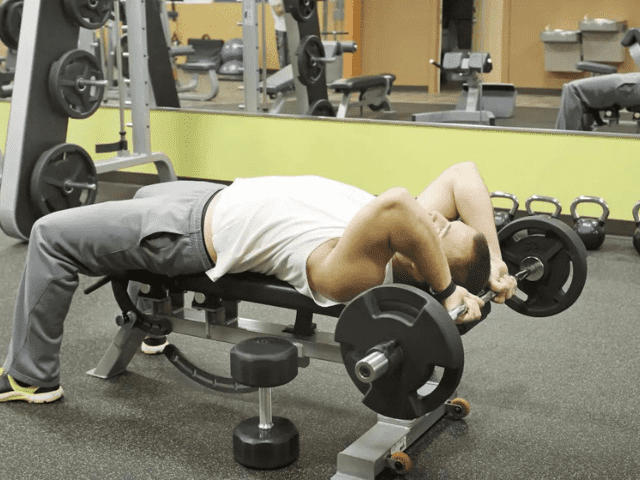
My final alternative for dips is Barbell Skull Crushers. They are yet another great movement for building triceps strength and size.
Step-by-Step Instructions
- Grab a bar with an overhand grip, lie flat on a bench with head down, chin up. If you don’t have a bench, you can simply lay on the floor.
- Press the bar to arm’s length above the shoulder.
- Lower the bar until it almost touches the top of the forehead, bending arms at the elbows, keeping upper arm vertical and elbows in.
- Drive the bar back up to the starting position and repeat.
Coaching Points
Keep the elbows high throughout. When Skull Crushers start to become difficult, the natural tendency of the lifter is to drop the elbows. Keep the elbows high and tight (try not to let them flare out to the side either).
*You can use a straight barbell or an EZ Curl Bar although most lifters prefer a Curl Bar because of the angle it allows the wrist to turn.

Get Shredded… For Free
Get a free workout Monday through Friday, posted right here on Horton Barbell. These workouts are designed to help you get strong, in shape and look great at the beach!
Final Thoughts
Dips are an excellent exercise for developing a strong chest, shoulders and triceps, but sometimes dips just aren’t an option.
You may not have the proper equipment available to you or at other times you might just be looking to add some variety to your workout routine.
In these situations, you’ll need an exercise to take their place and I hope that at least one of these alternatives to Dips I’ve listed here fits what you were looking for.
Worst case scenario, regular ol’ Push-ups can make a good substitute for Dips and don’t require any equipment at all.

